Abstract
This research aims to examine the mediating effects of eco-innovation practices in the relationship between the drivers of eco-innovation and the performance of tourism and hospitality enterprises. A quantitative approach was adopted in this research using questionnaire surveys as an instrument for collecting primary data. Based on the convenience sampling technique, a total of 550 questionnaire forms were distributed to five-star hotels and travel agencies in Cairo. Out of the distributed forms, only 400 forms were filled out and returned to the researchers and thus valid for analysis, representing a response rate of 72.7%. Structural Equation Modeling (SEM) using partial least squares (PLS-SEM) was employed to test the research model. The results showed the significant effect of independent variables on dependent variables through mediating variables. Multiplied path coefficients were used to measure the confidence interval (CI) for measuring the mediating relationship. The results supported the effect of eco-innovation practices as a mediating factor in the relationship between the drivers of eco-innovation and the performance of tourism and hospitality enterprises. The findings also showed that the eco-innovation drivers, which include management awareness, organizational capabilities, and environmental strategy, have a significant effect on eco-innovation practices and tourism/hospitality enterprise performance when integrating the mediating variables of eco-innovation practices. There are a few studies that have also examined a conceptual framework to examine eco-innovation practices as mediating factors in the relationship between the drivers of eco-innovation and the performance of tourism and hospitality enterprises in terms of five-star hotels and travel agencies in Egypt. Consequently, this research contributes to the literature related to tourism and hospitality management through highlighting the mediating effect of eco-innovation practices on the relationship between the drivers of eco-innovation and the performance of tourism and hospitality enterprises.
Keywords:
eco-innovation drivers; eco-innovation; practices; performance; hotels; travel agent; Egypt 1. Introduction
Climate change is a mainstream issue in the world today. Environmental sustainability practices are considered the main core of tourism and hospitality businesses (Mady et al. 2022). Moreover, most of the world’s countries cooperate closely on environmental policies concerning climate change, pollution, and global warming (Afshari et al. 2020; Han and Chen 2021). Hence, there is a relationship between sustainability and innovation (Chistov et al. 2023). These issues have encouraged many countries to pursue long-term economic goals through the implementation of environmental strategies (Martínez-Martínez et al. 2019). Tourism and hospitality businesses tend to adopt eco-innovation practices in their operations to improve business performance and achieve competitive advantages (Han and Chen 2021). For example, the hospitality sector began to adopt eco-innovation practices to reduce environmental impacts by implementing sustainable practices in its operations (Saez-Martinez et al. 2016; Horbach et al. 2016).
Likewise, environmental awareness is a critical aspect for creating competitive advantages in the tourism and hospitality industry (Fernández et al. 2021). Sustainability practices are key to enhancing business finance; therefore, many tourism and hospitality sectors have developed eco-friendly products and processes. Eco-friendly refers to the eco-innovation concept, in which operational practices are environmentally friendly and less harmful to the environment (Sanni 2018). Increasing environmental awareness in the corporate sector plays an important role in achieving competitive advantages and is considered a key factor in financial improvement (McDonagh and Prothero 2014; Díaz-García et al. 2015).
Despite the prevalence of studies analyzing eco-innovation without distinguishing between industries, prior research has not yet identified the factors that lead to eco-innovation in the tourism sector around the world. Innovation is generally fueled by access to sources of knowledge and the intensity of their use (Alos-Simo et al. 2023). In practice, some companies are far more innovative than other eco-innovators (Saez-Martinez et al. 2016). Similarly, Horbach et al. (2016) found that eco-innovation activities need to be informed by more external knowledge. Consequently, there are differences in the determinants of environmental innovation, which calls for further studies on this subject due to its importance in improving the performance of tourism and hospitality enterprises (Han and Chen 2021). Nonetheless, some studies dealing with motivations for adopting environmental innovation include external factors reflected in government regulations and customer preferences, while internal factors include environmental awareness and organizational capabilities (Fernández et al. 2021). Furthermore, eco-innovation research in the tourism and hospitality industries is still in its infancy, providing a multitude of study opportunities in a range of contexts (Saez-Martinez et al. 2016). In addition, there are still opportunities for further studies and research in environmental innovation as there are some research gaps that need to be addressed. First, there are only a few studies that have dealt with the environment in the tourism and hospitality sector and its impact on business performance. Second, most of the studies that have dealt with this topic were applied only in the industrial sector (Han and Chen 2021; Chen et al. 2017). Eco-innovation strategy presents a solution for the environmental problem and helps organizations improve their competitiveness to remain in the market (Kanda et al. 2018; Cecere et al. 2020).
Eco-innovation is defined as a new production or service process provided by an organization to increase its life cycle and reduce environmental risks to which it is exposed (Wang et al. 2020). This study differs from previous ones because eco-innovation requires a lot of external information, and this study is not limited to incentives for environmental innovation and their impact on the performance of hospitality and tourism businesses (Wang et al. 2020; Aboelmaged 2018). Prior research revealed that the hospitality industry is the least innovative service business, and we still know relatively little about the predecessors of tourism innovation in general, particularly regarding the sustainability of tourism (Garay and Font 2016; Martín-Rios and Ciobanu 2019). Consequently, this research aims to identify eco-innovation practices as mediating factors in the relationship between the drivers of eco-innovation and the performance of tourism and hospitality enterprises.
2. Theoretical Background and Hypotheses Development
2.1. Eco-Innovation Concept
The increased awareness of climate change has resulted in higher demand for products and services that help reduce negative impacts on the environment (Sharma et al. 2020). This has prompted many business organizations to improve their environmental performance by adopting innovative ways to address environmental issues (Sun et al. 2021). Tourism and hospitality organizations are striving to be environmentally friendly as eco-innovations have become synonymous with green revenues and sustainable services (Wang et al. 2020). Eco-innovation is a trend that helps an organization present new products, services, or management practices. Also, it assists organizations to survive and succeed in highly competitive markets (Han and Chen 2021). In the meantime, other studies (Sun et al. 2021; Chen et al. 2020) have reported that eco-innovation is used seen interchangeably with the terms green and sustainable. However, eco-innovation is considered one of the sub-components of innovation that deals with environmental problems. Accordingly, eco-innovation is divided into four types: eco-process innovation, eco-product innovation, eco-organizational innovation, and eco-marketing innovation (Sun et al. 2021; Hizarci-Payne et al. 2021). There are many definitions of eco-innovation, but two of them are more comprehensive and widely adopted. The first definition refers to eco-innovation as a new list of products and processes that can create a competitive advantage and increase value for customers in addition to reducing factors that negatively affect the environment. The second definition identifies eco-innovation as the process of modernizing and improving products and services, organizational redesign of institutions, and innovation for new methods of marketing that improve the use and exploitation of natural resources (Chen et al. 2020; Magadán-Díaz et al. 2019). Similarly, Sharma et al. (2020) highlighted that eco-innovation in the tourism and hospitality business refers to a set of practices that help save energy and reduce water consumption and waste production.
2.2. Eco-Innovation Drivers
According to previous studies (Mady et al. 2022; Han and Chen 2021), there are several factors that can drive tourism and hospitality enterprises to implement eco-innovation practices, such as management awareness, organizational capabilities, and environmental strategy. Given the importance of these elements, as mentioned in previous studies, we can use these items as the drivers of eco-innovation, as described below.
2.3. Management Awareness
The success of the application of eco-innovation strategies depends on the extent to which an organization’s management believes in these strategies (Wang et al. 2020). Also, the eco-innovation strategy depends mainly on the analysis of the external environment conducted by top management (Sharma et al. 2020). The study by Sumrin et al. (2021) reported that decision makers seek to implement environmental creativity and innovation in services and products provided to the customer. In addition, managers’ awareness of environmental issues is one of the important motives for identifying green innovation practices and their importance to customers and competitors (Chistov et al. 2021). Additionally, the eco-innovation benefits motivate managers to adopt such practices in their businesses (Han and Chen 2021). Consequently, the management’s awareness of environmental issues has a direct relationship with eco-innovation (Sumrin et al. 2021). The study by Han and Chen (2021) indicated that the term “managerial environmental” refers to the interest of top management in environmental issues and environmental innovation strategies. Several studies have shown that management’s interest in environmental problems and environmental responsibility are the most important motives for the application of eco-innovation (Song et al. 2021; Zhang et al. 2020). However, the low level of training programs and the lack of managers’ awareness of eco-innovation are considered major barriers to adopting these practices (del Río González 2009).
2.4. Organizational Capabilities
The success of business enterprises depends on the availability of organizational capabilities and capacities that help them implement green practices (Mady et al. 2022). The term green capabilities has undergone many developments to reflect a mix of investments to promote environmental practices within hotels, such as green technologies and environmental management systems and strategies (Betts et al. 2018). The study by Cai and Li (2018) identified two models of internal capabilities that help adopt eco-innovation, represented in environmental organizational capabilities and technological capabilities. Therefore, companies with high technical and environmental capabilities are more eco-innovative, which enables them to be more responsive to environmental changes by providing environmental products and services (Hojnik and Ruzzier 2016). According to del Río González (2009), technological change is a necessary but not sufficient condition for a transition to sustainability. It is considered one of the factors that affect the environmental intensity of production and can reduce the risks resulting from the production process, thus reducing the number of negative effects on the environment. Moreover, there is a direct relationship between technology and innovation because it is one of the main elements of technological development (Del Río et al. 2015).
2.5. Environmental Strategy
The term environmental strategies refers to the restrictions and obligations imposed on companies and organizations with the aim of avoiding environmental degradation. These strategies identify innovative solutions based on the conditions of a specific country in order to restore degraded ecosystems (Han and Chen 2021). The study of del Río González (2009) found that the main drivers of product and process innovation were environmental legislation and environmental policy. The relevant literature has discussed the relationship between environmental strategies and eco-innovation (Frigon et al. 2020). A study by Liao and Tsai (2019) indicated that environmental strategies force organizations to implement green innovation. Similarly, environmental regulation variables play a critical role in eco-innovation adaptation (Del Río et al. 2015). The application of eco-innovation in hotels is among the strategic goals that hotels seek to achieve (Afshari et al. 2020; Han and Chen 2021). Moreover, a study by Wang et al. (2020) found that environmental pressures encourage hotels to foster environmental innovation through green investments. The study of Horbach et al. (2016) also reported that environmental regulation has a strong influence on eco-innovation.
2.6. Eco-Innovation Practices and Tourism/Hospitality Enterprise Performance
According to Menezes and Cunha (2016), there is a relationship between environmental innovation and organizational performance, which leads to the optimal use of inputs and cost reductions. That is, eco-innovation helps tourism and hotel enterprises to reduce costs, improve their public image, increase market share, and accomplish a competitive advantage which leads to improved performance (Liao and Tsai 2019). The results of the study by Ben Amara and Chen (2021) also indicate that environmental innovation leads to the creation of a competitive advantage. Therefore, there is a relationship between environmental innovation and competitive strategies (Wang et al. 2020). In the same context, Ben Amara and Chen (2021) reported that eco-innovation increases a company’s chances of saving costs by improving production and reducing the consumption of raw materials and energy. The environmental management system leads to the creation of effective environmental and regulatory capacities and practices to sustain the environment, such as designing green products, recycling, preventing pollution, and raising operating efficiency (Magadán-Díaz et al. 2019; Menezes and Cunha 2016). Nonetheless, the main objective of environmental management systems is to ensure continuous improvement by enhancing environmental and organizational capacities to raise environmental awareness (Song et al. 2021; Zhang et al. 2020).
The link between sustainability and performance is one of the important topics in the field of social responsibility for tourism and hospitality firms (Wang et al. 2020). Eco-innovation helps achieve a competitive advantage for companies, and this requires a sustainable effort to spread environmental knowledge and update it effectively (Martínez-Martínez et al. 2019). Eco-innovation for administrative products and processes has a positive correlation with organizational performance and helps hotel and tourism enterprises to increase profitability and create a competitive advantage through reduced costs and optimization of the use of resources and time (Aboelmaged 2018; Salim et al. 2019). In a similar vein, the study of Wang et al. (2020) found that eco-innovation improves the quality of services and products, resulting in increased customer satisfaction and an increase in a tourism and hospitality company’s market share. In addition, the implementation of eco-innovation practices helps raise the environmental awareness of both employees and customers, which increases sales and ensures customer loyalty (Sharma et al. 2020).
2.7. The Mediation Effects of Eco-Innovation Practices
The literature review indicated that eco-innovation helps tourism companies and hotels improve performance by reducing costs and increasing their market share while also improving their public image and customer loyalty (Aboelmaged 2018). Therefore, the mediating role of eco-innovation practices between the eco-innovation drivers includes management awareness, organizational capabilities, environmental strategy, and the performance of tourism and hotel establishments.
Based on the above-mentioned literature, this study postulates the following hypotheses and conceptual model:
H1.
Managers’ awareness of eco-innovation has a positive effect on eco-innovation practices.
H2.
Organizational capabilities have a positive effect on eco-innovation practices.
H3.
Environmental strategies have a positive effect on eco-innovation practices.
H4.
Eco-innovation practice has a positive effect on tourism and hospitality enterprise performance.
H5.
Eco-innovation mediates the relationship between management awareness and tourism/hospitality enterprise performance.
H6.
Eco-innovation mediates the relationship between organizational capabilities and tourism/hospitality enterprise performance.
H7.
Eco-innovation mediates the relationship between environmental strategy and tourism/hospitality enterprise performance.
The conceptual framework of this study (see Figure 1) examines eco-innovation practices as a mediator in the relationship between the drivers of eco-innovation and the performance of tourism and hospitality enterprises.
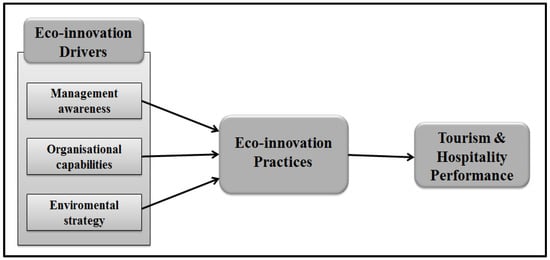
Figure 1.
The conceptual framework of tourism/hospitality eco-innovation.
3. Methodology
3.1. Data Collection
A quantitative approach was adopted in this study to test the postulated hypotheses. To collect the primary data, the researchers developed and administered a questionnaire survey based on a convenience sampling strategy. The questionnaire form (see Appendix A) was originally written in Arabic, as it is the respondents’ native language, and then translated into English. A total of 550 questionnaire forms were distributed in 18 five-star hotels (EHA 2023) and 30 travel agencies (ETAA 2023) in Cairo. Cairo was chosen by the researchers as the sample location since it is geographically convenient, which enabled better accessibility to participants. Moreover, Cairo is a major tourist city that includes diverse tourism and hospitality services. In addition, five-star hotels have a large amount of capital with sufficient financial support for eco-innovation activities that can help them keep pace with modern developments and apply eco-innovation practices. Delgado Cruz et al. (2016) reported that travel agencies face a huge challenge that requires them to understand how to develop innovation capabilities from within. However, a few years ago, the tourism sector was considered to exhibit little to no innovation because of its operational and regulatory tasks that only consumed innovations from the manufacturing sector, indicating its inability to generate innovations itself (Thomas and Wood 2014). However, recent findings indicate that innovation in travel agencies should be studied and treated differently through the presentation of certain characteristics, which indicates that the tourism sector plays an important role in the use and generation of innovations that allow for the effective management of resources, the generation of competitive advantages, and value creation (Delgado Cruz et al. 2016). The tourism and hospitality industry was purposefully chosen because it appears to have stronger green practices regardless of the size of the hospitality enterprise (Aboelmaged 2018). Eco-innovation is a tool for the survival of travel agents. It enables the development and provision of eco-products and eco-services that reduce the consumption of raw materials and energy and prevent pollution. It provides channels to attract new customers. Innovation also plays an important role in the tourism industry through improving financial performance and increasing customer satisfaction (Ben Amara and Chen 2021).
A convenience sample technique was employed in this study as it only requires the participants’ willingness to engage in the study. A total of 400 forms were returned to the researchers (either in paper-based form or online) and thus valid for analysis, representing a response rate of 72.7%.
3.2. Measurements
According to Denscombe (2017), quantitative research is the most popular method used in tourism and hospitality research. Therefore, the current study adopted a quantitative approach and used a questionnaire form for collecting primary data related to the research variables and hypotheses.
The questionnaire form involved 6 sections that included respondents’ demographic characteristics, management awareness (6 items), organizational capabilities (6 items), environmental strategies (7 items), eco-innovation practices (9 items), and tourism and hospitality enterprise performance (7 items). All the items used in the questionnaire were adapted from previous studies (see Table 1). A 5-point Likert scale was applied to measure the level of the constructs, where 1 = strongly disagree, 3 = neutral and, 5 = strongly agree. A pilot study was conducted among 20 participants from hotel and travel agency managers to ensure the reliability of the initial version of the questionnaire and to explore any potential misunderstandings among respondents regarding the wording of attributes or the length of the questionnaire. Pilot results helped enhance the clarity of the research variables and questions.

Table 1.
The measurements of research variables.
3.3. Data Analysis
The questionnaire was analyzed in three phases. The first phase was data analysis of the screening questionnaire, as suggested by Saunders et al. (2016). The second phase was descriptive analysis and included percentages and frequencies. The validity and reliability of the study measures were also confirmed through statistical tests such as composite reliability. The third phase included hypotheses testing.
Structural Equation Modeling (SEM) using partial least squares (PLS-SEM) was adopted in the current study. PLS-SEM was used to test the research model using SmartPLS 3 to assess both the measurement model and the structural model (Henseler et al. 2009). All the research constructs were adapted from previous studies, where their validity and reliability had been established.
3.4. Common Method Bias
The current research adopted a quantitative approach for measuring the study items, so there is no bias in this study. In addition, bias was mitigated in this study through some procedures. First, most participants had knowledge about the study topic and the questions were clear and precise, which reduced the amount of inaccurate or dishonest answers. Secondly, the average variance extracted (AVE) value for study factors was higher than 0.5, which indicated that the measurement of the study model was acceptable and that there was no bias in the data.
4. Results and Discussion
4.1. Descriptive Analysis
Table 2 shows the profiles of the respondents. A total of 290 (72.5%) of the study respondents were males, whereas 110 (27.5%) of them were females. In terms of work experience, the results show that 155 (38.7%) of the respondents had worked for more than 20 years, and 165 (20%) of the respondents had work experience between 16 and 20 years. Also, 100 (25%) of the respondents were categorized to have between 10 and 15 years of experience, while 20 (5%) of the respondents had 9 years or less of work experience. More than half of the respondents (215, i.e., 53.7%) had a bachelor’s degree, followed by 160 (30%) respondents with a diploma degree and 65 (16.3%) with a master’s degree or higher.

Table 2.
Profiles of respondents (n = 400).
4.2. The Measurement Model
SmartPLS 3.0 was used in this research to obtain partial least squares of the structural equation model (PLS-SEM) to measure model validation and test the relationships between research hypotheses in the structural model. The study of Wang et al. (2020) reported that it is necessary to test questionnaire items using parceling tactics to improve model fit and obtain accurate estimates. There are several tests used to measure construct validity (see Table 3 and Table 4). Firstly, the significant loading of confirmatory factor analysis (CFA) (p < 0.001) results showed that the minimum value of construct loading was 0.729 (see Figure 2). The study of Gefen and Straub (2005) reported that factor loading must exceed a value of 0.60. Secondly, for testing the internal reliability of the model constructs, composite reliability (CR) was examined. The results showed that the CR value for all variables was above the recommended value of 0.70. Thirdly, the average variance extracted (AVE) value was higher than 0.5, which refers to the fact that the measurement of the study model was acceptable (Henseler et al. 2016). Fourth, the results showed that the square root of the AVE value was significantly higher than the correlation of the internal constructs, which refers to an adequate level of satisfaction for convergent validity.

Table 3.
Results of the measurement model.

Table 4.
Results of validity and reliability measures.
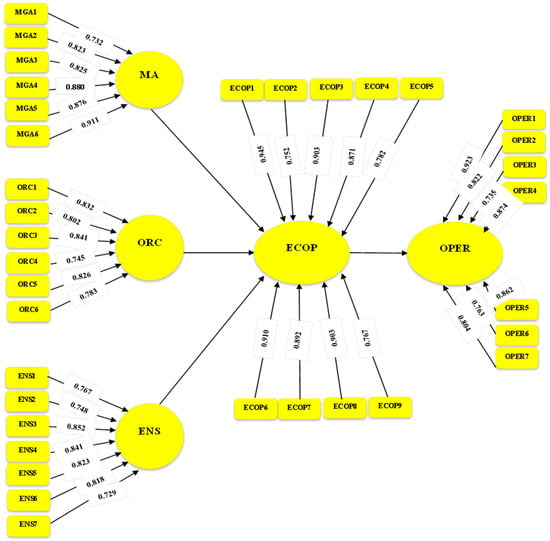
Figure 2.
Results of standardized factor loadings.
4.3. The Research Structural Model
Coefficients of determination (R2) and the significance of paths were used for data analysis, with the results showing that eco-innovation is influenced by the MA, ORC, and ENS variables (see Table 5 and Figure 3). The results showed that all eco-innovation drivers, including management awareness (MA), organizational capabilities (ORC), and environmental strategy (ENS), have a significant effect on eco-innovation practices. First, managers’ awareness of eco-innovation has a positive effect on eco-innovation practices (β = 0.523, t = 5.230, p < 0.001). The path coefficient between them is high, and this study therefore supports the alternative hypothesis and rejects the null hypothesis. Second, the path coefficient between an organization’s capabilities and eco-innovation practices (β = 0.365, t = 4.694, p < 0.001) shows a significant effect between them; thus, the alternative hypothesis was also supported. Third, the path coefficient between environmental strategies and eco-innovation practices (β = 0.365, t = 4.694, p < 0.001) is significant. Fourth, eco-innovation practices have a positive and significant effect on tourism and hospitality enterprise performance (β = 0.356, t = 2.351, p < 0.001).

Table 5.
Results of path coefficients for the hypotheses.
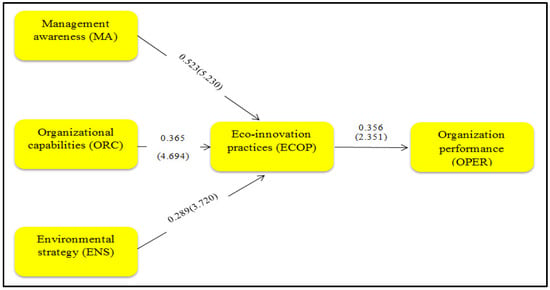
Figure 3.
Relationships between analyzed study variables.
4.4. The Mediation Variable of Eco-Innovation
This research set out to test the mediating effect of eco-innovation practices between the drivers of eco-innovation (management awareness, organizational capabilities, environmental strategy) and the performance of tourism and hospitality enterprises. PLS-SEM results showed a significant effect for independent variables (IV) on dependent variables (DV) through mediating variables (MV). The significant effect indicated that the mediating variables existed; hence, the t-value should be measured. Multiplied path coefficients were used to measure the confidence interval (CI) for measurements of the mediating relationship. If the confidence value of the mediating variable does not include zero, this indicates that the indirect effect of the mediating variable is significantly different from zero (Saez-Martinez et al. 2016).
Consequently, the results showed that management awareness indirectly influences tourism and hospitality enterprise performance (β = 0.316, t = 4.345, p < 0.01, CI: 0.162–0.243); thus, the fifth hypothesis (“eco-innovation is mediating the relationship between management awareness and tourism/hospitality performance”) is confirmed. In addition, organizational capability indirectly influences tourism and hospitality enterprise performance (β = 0.248, t = 4.451, p < 0.01, CI: 0.143–0.235) through eco-innovation practices; thus, the sixth hypothesis (“eco-innovation is mediating the relationship between organizational capabilities and tourism/hospitality performance”) is also supported. Additionally, environmental strategy indirectly impacts tourism and hospitality performance (β = 0.142, t = 3.521, p < 0.01, CI: 0.132–0.148), and this result shows that the seventh hypothesis is accepted and confirms the mediating role of eco-innovation in the relationship between environmental strategy and tourism/hospitality enterprise performance. This indicates that the effect of the three direct variables (eco-innovation drivers including management awareness, organizational capabilities, and environmental strategy) is positive and has an effect when integrating the mediating variable (eco-innovation practices) (see Table 6).

Table 6.
Results of multiplying path coefficients for a confidence interval.
5. Discussion
This research is a response to the call for a more thorough study of applications of eco-innovation beyond the manufacturing and industrial sectors (Alonso-Almeida et al. 2016; García-Pozo et al. 2015). It also contributes to sustainability knowledge by linking eco-innovation to environmental orientation and environmental supplier collaboration, as well as examining their effects on tourism and hospitality enterprise performance in a developing country context. This study therefore challenges an underlying theme of most previous studies that focused on institutional regulation and stakeholder pressure as drivers of the implementation of environmental innovation. Unlike previous studies, our study also considers the mediating role of eco-innovation practices and environmental supplier cooperation in tourism and hospitality business performance. Drawing from relational theory, this study developed seven hypotheses and established a conceptual model to interpret the structural relationships between environmental variables and the performance of tourism and hospitality businesses. Six hypotheses were supported, providing empirical evidence of the essential role of environmental orientation and eco-innovation practices in the hotel industry.
The results provide empirical evidence that supports the direct and mediating effects of eco-innovation practices on the performance of tourism and hospitality enterprises, which expands existing research on the crucial role of eco-innovation in bonding the sustainability–performance link. Thus, hotel managers can implement eco-innovation practices as a new strategic weapon that proactively meets sustainability requirements and enhances the hotel’s competitiveness (e.g., improved efficiency, reduced waste, and increased productivity and profitability) in order to fulfill the hotel’s financial (e.g., market share and sales) and non-financial (e.g., improve the hotel’s image and foster guest loyalty) performance targets. On a similar note, implementing eco-innovation in tourism and hospitality contributes to improving operational performance and reducing costs. It also helps them improve product and service processes, which will positively influence customer satisfaction and increase market share (Wang et al. 2020; Ben Amara and Chen 2021). The findings also reveal that product, process, and organizational innovation play a critical role in influencing the implementation of eco-innovation. In addition, the results show that eco-innovation is considered one of the most important issues related to competitive advantages for tourism and hospitality enterprises as it enables them to divide the market into segments of customers who are environmentally conscious and who want to enjoy the environment in a sustainable way (Sun et al. 2021).
The findings also support the impact of eco-innovation practices as a mediating factor in the relationship between eco-innovation drivers and tourism and hospitality enterprise performance. Eco-innovation driving forces such as managerial awareness, organizational skills, and environmental strategies have a significant impact on eco-innovation practices.
Although several studies have investigated eco-innovation in various sectors, these studies did not identify the factors driving eco-innovation in the tourism and hospitality sector (Alos-Simo et al. 2023). Similarly, few studies offer a conceptual framework to examine eco-innovation practices as a mediating factor in the relationship between the drivers of eco-innovation and the performance of tourism and hospitality enterprises in relation to five-star hotels and travel agencies in Egypt. Consequently, this study contributes to theory by identifying the mediating role of eco-innovation practices in the link between the forces driving eco-innovation and the performance of tourism and hospitality enterprises. The results indicate that awareness of environmental issues within management fosters the desire to adopt eco-innovation efforts, whether it be eco-products or eco-processes, which concurs with the literature review (Mady et al. 2022; Cai and Li 2018). In addition, organizational capabilities are considered the main driver for adopting eco-innovation practices. This is consistent with a study conducted by Aboelmaged and Hashem (2019) which reported that organizational capabilities play a critical role in adopting eco-innovation strategies and practices, especially in the tourism and hospitality sectors.
6. Conclusion and Research Implications
This study developed a conceptual framework to examine eco-innovation practices as a mediating factor in the relationship between the drivers of eco-innovation and the performance of tourism and hospitality enterprises. Five-star hotels and travel agencies in Cairo were selected based on a convenient sampling technique to recruit the participating five-star hotels and travel agencies. The results of this study agree with the relevant literature that suggests the drivers of eco-innovation play a critical role in implementing eco-innovation in hotels (Mady et al. 2022; Sumrin et al. 2021). The mediating effect of eco-innovation practices in the relationship between the drivers of eco-innovation and the performance of tourism and hospitality enterprises was supported by the study results and is consistent with prior studies (Sumrin et al. 2021; Chistov et al. 2021). The results support all the research hypotheses. Firstly, managerial awareness of eco-innovation has a positive effect on eco-innovation practices, and this result concurs with the study of Sumrin et al. (2021) which proved that managerial awareness of environmental issues has a direct relationship with eco-innovation. Secondly, the path coefficient between organization capabilities and eco-innovation practices is significant; this result is also consistent with the literature review (Mady et al. 2022). Thirdly, the path coefficient between environmental strategies and eco-innovation practices indicates a positive effect, as indicated by previous studies (Frigon et al. 2020). Fourthly, the path coefficients of eco-innovation practices have a positive effect on tourism and hospitality enterprise performance. This result agrees with the study of Menezes and Cunha (2016) which indicated that there is a relationship between environmental innovation and organizational practice, which leads to the optimal use of inputs and reduced costs. The results also confirmed the fifth, sixth, and seventh hypotheses, which refer to the fact that management awareness, organizational capability, and environmental strategy have a positive effect when eco-innovation practices are used as the mediating variable.
Based on the study results, this study provides some implications for tourism and hospitality managers and policymakers. Tourism and hospitality businesses are strongly advised to adopt eco-innovation. For that to be accomplished, management awareness and environmental strategy are critical to implementing eco-innovation practices. Consequently, managers of tourism and hospitality businesses need to adopt and integrate environmental practices into their operations to enhance performance and protect the environment. It is also necessary to provide the organizational capabilities required for the implementation of eco-innovation practices. Tourism and hospitality managers should foster collaboration with universities and governmental authorities to raise awareness of the importance of adopting eco-innovation practices. Finally, tourism and hospitality managers need to reinforce their organizational capabilities and environmental strategies.
7. Research Limitations
The prevalent limitation of this study is its geographically confined sample as it focused mainly on five-star hotels and travel agencies in Cairo. Thus, future studies can investigate a wider variety of hotels and travel agencies from multiple cities in Egypt to generalize these results. Few previous studies have provided a conceptual framework to investigate eco-innovation practices as a mediating factor in the relationship between the drivers of eco-innovation and the performance of tourism and hospitality enterprises in Egypt. Thus, by identifying the mediating role of eco-innovation practices in the relationship between the drivers of eco-innovation and the performance of tourism and hospitality enterprises, this research makes a theoretical contribution.
Author Contributions
Conceptualization, M.A., M.Y.K.A. and M.F.A.; data curation, M.A., N.K., M.F.A. and N.A.; formal analysis, M.A., M.F.A. and M.Y.K.A.; funding acquisition, N.K., N.A.; investigation, M.F.A. and M.A.; methodology, M.A., N.A., M.F.A. and N.K.; project administration, M.Y.K.A., M.A. and M.F.A.; resources, N.K., N.A., M.F.A. and M.A.; software N.K. and N.A.; supervision, M.F.A. and M.A.; validation, M.A., M.Y.K.A., N.A. and M.F.A.; visualization, M.F.A., N.A., M.A. and N.K. writing—original draft, M.F.A., M.A. and M.Y.K.A.; writing—review and editing, M.A., M.F.A., M.Y.K.A. and N.A. All authors have read and agreed to the published version of the manuscript.
Funding
This work was supported by the Deanship of Scientific Research, Vice Presidency for Graduate Studies and Scientific Research, King Faisal University, Saudi Arabia [Project No. GRANT3800].
Institutional Review Board Statement
Not applicable.
Informed Consent Statement
Informed consent was obtained from all subjects involved in the study.
Data Availability Statement
Data are available upon request from researchers who meet the eligibility criteria. (Kindly contact the first author privately through email.)
Conflicts of Interest
The authors declare no conflict of interest.
Appendix A
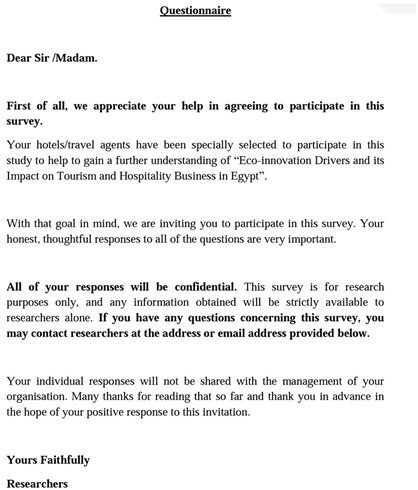
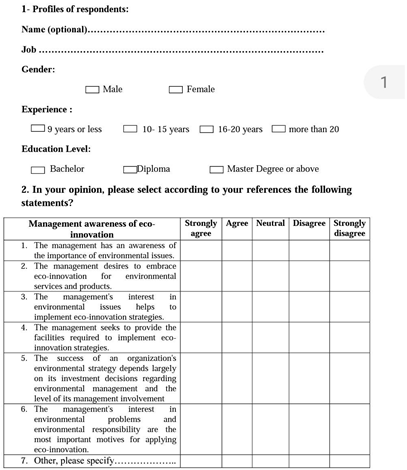
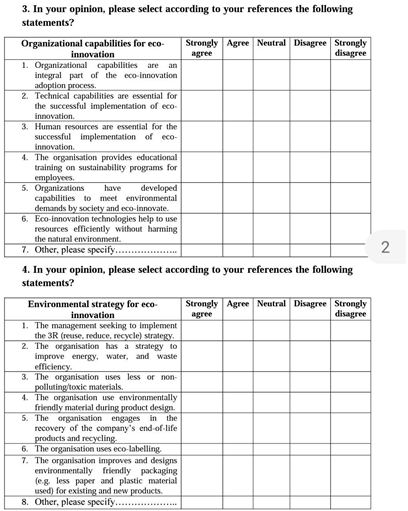
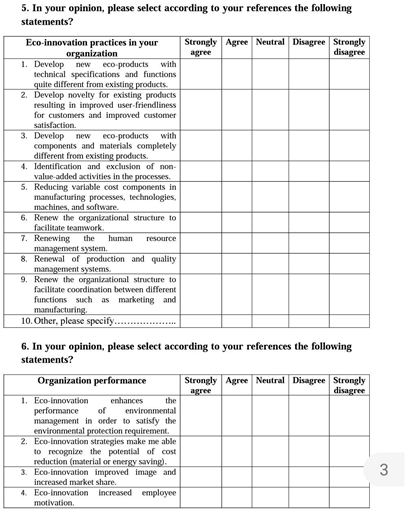
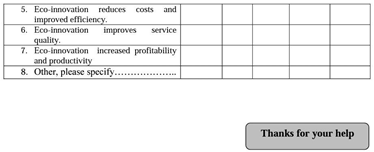
References
- Aboelmaged, Mohamed. 2018. Direct and indirect effects of eco-innovation, environmental orientation and supplier collaboration on hotel performance: An empirical study. Journal of Cleaner Production 184: 537–49. [Google Scholar] [CrossRef]
- Aboelmaged, Mohamed, and Gharib Hashem. 2019. Absorptive capacity and green innovation adoption in SMEs: The mediating effects of sustainable organizational capabilities. Journal of Cleaner Production 220: 853–63. [Google Scholar] [CrossRef]
- Afshari, Hamid, Cory Searcy, and Mohamad Y. Jaber. 2020. The role of eco-innovation drivers in promoting additive manufacturing in supply chains. International Journal of Production Economics 223: 107538. [Google Scholar] [CrossRef]
- Alonso-Almeida, Maria-del-Mar, Alfredo Rocafort, and Fernando Borrajo. 2016. Shedding light on eco-innovation in tourism: A critical analysis. Sustainability 8: 1662. [Google Scholar] [CrossRef]
- Alos-Simo, Lirios, Antonio J. Verdu-Jover, and Jose M. Gomez-Gras. 2023. How use of knowledge sources influences eco-innovation in the tourism sector through product innovation and/or process innovation. Journal of Sustainable Tourism, 1–20. [Google Scholar] [CrossRef]
- Ben Amara, Dhekra, and Hong Chen. 2021. Evidence for the mediating effects of eco-innovation and the impact of driving factors on sustainable business growth of agribusiness. Global Journal of Flexible Systems Management 22: 251–66. [Google Scholar] [CrossRef]
- Betts, Teresa K., Janice Francis Super, and Jeremy North. 2018. Exploring the influence of institutional pressures and production capability on the environmental practices-Environmental performance relationship in advanced and developing economies. Journal of Cleaner Production 187: 1082–93. [Google Scholar] [CrossRef]
- Cai, Wugan, and Guangpei Li. 2018. The drivers of eco-innovation and its impact on performance: Evidence from China. Journal of Cleaner Production 176: 110–18. [Google Scholar] [CrossRef]
- Cecere, Grazia, Nicoletta Corrocher, and Maria Luisa Mancusi. 2020. Financial constraints and public funding of eco-innovation: Empirical evidence from European SMEs. Small Business Economics 54: 285–302. [Google Scholar] [CrossRef]
- Chen, Jun, Jinhua Cheng, and Sheng Dai. 2017. Regional eco-innovation in China: An analysis of eco-innovation levels and influencing factors. Journal of Cleaner Production 153: 1–14. [Google Scholar] [CrossRef]
- Chen, Quan, Chun-Hsien Wang, and Shi-Zheng Huang. 2020. Effects of organizational innovation and technological innovation capabilities on firm performance: Evidence from firms in China’s Pearl River Delta. Asia Pacific Business Review 26: 72–96. [Google Scholar] [CrossRef]
- Chistov, Valery, Nekane Aramburu, and Javier Carrillo-Hermosilla. 2021. Open eco-innovation: A bibliometric review of emerging research. Journal of Cleaner Production 311: 167627. [Google Scholar] [CrossRef]
- Chistov, Valery, Nekane Aramburu, María Eugenia Fabra Florit, Iñaki Peña-Legazkue, and Pauline Weritz. 2023. Sustainability orientation and firm growth as ventures mature. Business Strategy and the Environment, 1–18. [Google Scholar] [CrossRef]
- del Río González, Pablo. 2009. The empirical analysis of the determinants for environmental technological change: A research agenda. Ecological Economics 68: 861–78. [Google Scholar] [CrossRef]
- Del Río, Pablo, Desiderio Romero-Jordán, and Cristina Peñasco. 2015. Analyzing firm-specific and type-specific determinants of eco-innovation. Technological and Economic Development of Economy 23: 270–95. [Google Scholar] [CrossRef]
- Delgado Cruz, Alejandro, Elva Esther Vargas Martínez, Juan Manuel Montes Hincapié, and Federico Rodríguez Torres. 2016. Innovation in tourism companies, where are they and where are they going? An approach to the state of knowledge. Intangible Capital 16: 1088–155. [Google Scholar] [CrossRef]
- Denscombe, Martyn. 2017. EBOOK: The Good Research Guide: For Small-Scale Social Research Projects. London: McGraw-Hill Education. [Google Scholar]
- Díaz-García, Cristina, Ángela González-Moreno, and Francisco J. Sáez-Martínez. 2015. Eco-innovation: Insights from a literature review. Innovation 17: 6–23. [Google Scholar] [CrossRef]
- EHA. 2023. Egyptian Hotel Association. Available online: http://www.egyptianhotels.org/Home/Hotels?search=&CategoriesIDFKEN=5&HotelsTypesIDFKEN=3&CityIDFKEN=11 (accessed on 10 April 2023).
- ETAA. 2023. Egyptian Travel Agents Association. Available online: https://www.etaa-egypt.org/SitePages/Companies.aspx (accessed on 15 April 2023).
- Fernández, Sara, Celia Torrecillas, and Romilio Ernesto Labra. 2021. Drivers of eco-innovation in developing countries: The case of Chilean firms. Technological Forecasting and Social Change 170: 160902. [Google Scholar] [CrossRef]
- Frigon, Anthony, David Doloreux, and Richard Shearmur. 2020. Drivers of eco-innovation and conventional innovation in the Canadian wine industry. Journal of Cleaner Production 275: 164115. [Google Scholar] [CrossRef]
- Garay, Luis, and Xavier Font. 2016. Doing good to do well? Corporate social responsibility reasons, practices and impacts in small and medium accommodation enterprises. International Journal of Hospitality Management 31: 329–37. [Google Scholar] [CrossRef]
- García-Pozo, Alejandro, José Luis Sánchez-Ollero, and Macarena Marchante-Lara. 2015. Eco-innovation and management: An empirical analysis of environmental good practices and labor productivity in the Spanish hotel industry. Innovation 17: 58–68. [Google Scholar] [CrossRef]
- Gefen, David, and Detmar Straub. 2005. A practical guide to factorial validity using PLS-Graph: Tutorial and annotated example. Communications of the Association for Information Systems 16: 5. [Google Scholar] [CrossRef]
- Han, Myat Su, and Weiming Chen. 2021. Determinants of eco-innovation adoption of small and medium enterprises: An empirical analysis in Myanmar. Technological Forecasting and Social Change 173: 161146. [Google Scholar] [CrossRef]
- Henseler, Jörg, Christian M. Ringle, and Rudolf R. Sinkovics. 2009. The use of partial least squares path modeling in international marketing. Advances in International Marketing 20: 277–319. [Google Scholar]
- Henseler, Jörg, Geoffrey Hubona, and Pauline Ash Ray. 2016. Using PLS path modeling in new technology research: Updated guidelines. Industrial Management & Data Systems 116: 2–20. [Google Scholar]
- Hizarci-Payne, Ayça Kubra, İlayda İpek, and Gülüzar Kurt Gümüş. 2021. How environmental innovation influences firm performance: A meta-analytic review. Business Strategy and the Environment 30: 1174–90. [Google Scholar] [CrossRef]
- Hojnik, Jana, and Mitja Ruzzier. 2016. What drives eco-innovation? A review of an emerging literature. Environmental Innovation and Societal Transitions 19: 31–41. [Google Scholar] [CrossRef]
- Horbach, Jens, Christian Rammer, and Klaus Rennings. 2016. Determinants of eco-innovations by type of environmental impact—The role of regulatory push/pull, technology push and market pull. Ecological Economics 78: 116–62. [Google Scholar] [CrossRef]
- Kanda, Wisdom, Olof Hjelm, Jens Clausen, and Dzamila Bienkowska. 2018. Roles of intermediaries in supporting eco-innovation. Journal of Cleaner Production 205: 1006–16. [Google Scholar] [CrossRef]
- Kim-Soon, Ng, Abd Rahman Ahmad, Chan Wei Kiat, and Hairul Rizad. 2017. SMEs are embracing innovation for business performance. Journal of Innovation Management in Small & Medium Enterprises 1: 1–17. [Google Scholar]
- Liao, Yi-Chuan, and Kuen-Hung Tsai. 2019. Innovation intensity, creativity enhancement, and eco-innovation strategy: The roles of customer demand and environmental regulation. Business Strategy and the Environment 28: 316–26. [Google Scholar] [CrossRef]
- Mady, Khalid, Muhammad Abi Sofian Abdul Halim, and Khatijah Omar. 2022. Drivers of multiple eco-innovations and the impact on sustainable competitive advantage: Evidence from manufacturing SMEs in Egypt. International Journal of Innovation Science 14: 40–61. [Google Scholar] [CrossRef]
- Magadán-Díaz, Marta, Marios Sotiriadis, and Jesús Rivas-García. 2019. Drivers of eco-innovation in the Spanish hospitality industry. Tourismos: An International Multidisciplinary Journal of Tourism 14: 119–36. [Google Scholar]
- Martínez-Martínez, Aurora, Juan-Gabriel Cegarra-Navarro, Alexeis Garcia-Perez, and Anthony Wensley. 2019. Knowledge agents as drivers of environmental sustainability and business performance in the hospitality sector. Tourism Management 70: 381–89. [Google Scholar] [CrossRef]
- Martín-Rios, Carlos, and Teofil Ciobanu. 2019. Hospitality innovation strategies: An analysis of success factors and challenges. Tourism Management 70: 218–29. [Google Scholar] [CrossRef]
- McDonagh, Pierre, and Andrea Prothero. 2014. Sustainability marketing research: Past, present and future. Journal of Marketing Management 30: 1186–619. [Google Scholar] [CrossRef]
- Menezes, V. O., and S. K. Cunha. 2016. Eco-innovation and competitive strategy in global hotel chains: Developing a conceptual relationship model. WIT Transactions on Ecology and the Environment 201: 177–88. [Google Scholar]
- Saez-Martinez, Francisco Jose, Laura Avellaneda-Rivera, and Angela Gonzalez-Moreno. 2016. Open and green innovation in the hospitality industry. Environmental Engineering and Management Journal 15: 1481–87. [Google Scholar] [CrossRef]
- Salim, Norhuda, Mohd Nizam Ab Rahman, and Dzuraidah Abd Wahab. 2019. A systematic literature review of internal capabilities for enhancing eco-innovation performance of manufacturing firms. Journal of Cleaner Production 209: 1445–60. [Google Scholar] [CrossRef]
- Sanni, Maruf. 2018. Drivers of eco-innovation in the manufacturing sector of Nigeria. Technological Forecasting and Social Change 131: 303–14. [Google Scholar] [CrossRef]
- Saunders, Mark N. K., Philip Lewis, and Adrian Thornhill. 2016. Research Methods for Business Students, 6th ed. Harlow: Pearson Education. [Google Scholar]
- Sharma, Tanmay, Joseph Chen, and Wan Yu Liu. 2020. Eco-innovation in hospitality research (1998–2018): A systematic review. International Journal of Contemporary Hospitality Management 32: 913–33. [Google Scholar] [CrossRef]
- Song, Wenhao, Hongyan Yu, and Hui Xu. 2021. Effects of green human resource management and managerial environmental concern on green innovation. European Journal of Innovation Management 24: 951–67. [Google Scholar] [CrossRef]
- Sumrin, Samina, Suraksha Gupta, Yousra Asaad, Yichuan Wang, Saurabh Bhattacharya, and Pantea Foroudi. 2021. Eco-innovation for environment and waste prevention. Journal of Business Research 162: 627–39. [Google Scholar] [CrossRef]
- Sun, Yunpeng, Ozlem Ates Duru, Asif Razzaq, and Marius Sorin Dinca. 2021. The asymmetric effect of eco-innovation and tourism towards the carbon neutrality target in Turkey. Journal of Environmental Management 299: 113653. [Google Scholar] [CrossRef]
- Thomas, Rhodri, and Emma Wood. 2014. Innovation in tourism: Re-conceptualising and measuring the absorptive capacity of the hotel sector. Tourism Management 45: 39–48. [Google Scholar] [CrossRef]
- Tumelero, Cleonir, Roberto Sbragia, and Steve Evans. 2019. Cooperation in R & D and eco-innovations: The role in companies’ socioeconomic performance. Journal of Cleaner Production 207: 1138–49. [Google Scholar]
- Wang, Yajun, Xavier Font, and Jingyan Liu. 2020. Antecedents, mediation effects and outcomes of hotel eco-innovation practice. International Journal of Hospitality Management 85: 102345. [Google Scholar] [CrossRef]
- Zhang, Yali, Jun Sun, Zhaojun Yang, and Ying Wang. 2020. Critical success factors of green innovation: Technology, organization and environment readiness. Journal of Cleaner Production 264: 1617. [Google Scholar] [CrossRef]
Disclaimer/Publisher’s Note: The statements, opinions and data contained in all publications are solely those of the individual author(s) and contributor(s) and not of MDPI and/or the editor(s). MDPI and/or the editor(s) disclaim responsibility for any injury to people or property resulting from any ideas, methods, instructions or products referred to in the content. |
© 2023 by the authors. Licensee MDPI, Basel, Switzerland. This article is an open access article distributed under the terms and conditions of the Creative Commons Attribution (CC BY) license (https://creativecommons.org/licenses/by/4.0/).